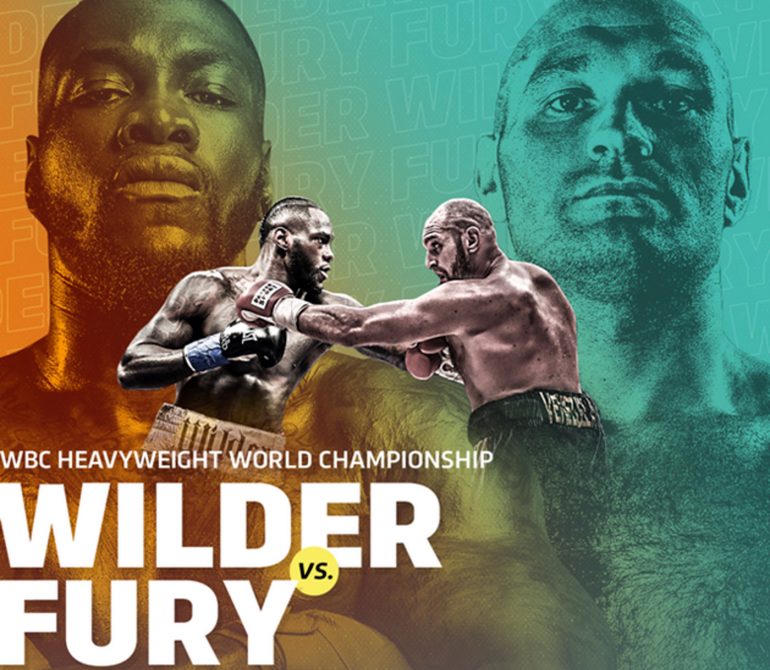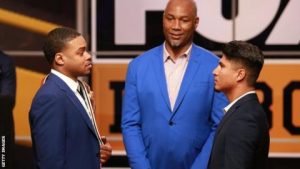Fistianados commentary: The PBC’s Pay-Per-Views

This is a continuing series of articles that looks at how the boxing world is adapting to the next technological age of broadcasting. Evan Rutkowski is a former HBO Sports marketing executive and host of the Fistianados Podcast, which looks at the business side of boxing. Click here to read the first and second commentary pieces of the series.
Listen to Rutkowski’s latest Fistianados Podcast:
The boxing universe has seen all kinds of network and promotional divides in the last few decades, but over the next four months we can add in a direct clash of business models with the way some of the biggest fights get made and sold to consumers. The Premier Boxing Champions (PBC), with Showtime and Fox as distributors, will showcase three pay-per-view fights that operate as a perfect summary of the problems with the old-school model of distributing high-level fights, and they will face intense competition primarily from DAZN as it brands itself as the anti-PPV distributor. In many ways, this figurative fight will be more important than any of the actual fights that will take place, because hardcore boxing fans will have real power to determine how much they want to consume their content moving forward.
This battle of ideas isn’t just PPV vs. non-PPV fights, though it’s framed that way now. PPV will likely never go away from the boxing universe, no matter what DAZN may claim. But the nature of PPV and the types of fights that consumers get for their monthly subscription to Showtime, ESPN+, or DAZN, or for networks like ESPN and Fox, is certainly at stake here. Network executives have traditionally been loath to discuss the finer points of PPV fights, but it’s not unusual for networks put up large guarantees for  fighter purses to make such fights. As PBC enters a period where it will show Deontay Wilder vs. Tyson Fury, Manny Pacquiao vs. Adrien Broner, and Errol Spence vs. Mikey Garcia, all on PPV in a four-month period, this could be true with Showtime and Fox. It’s easy to make a case that in the old pay cable system of paying fighters, the purse demands for these types of fighters in these types of fights automatically send the fights to PPV. In recent years, however, the PPV model has gotten completely out of whack. The super fights have generated extraordinary amounts of PPV buys and total revenue, smashing previous records, but the smaller PPV shows have struggled mightily. Expect this trend to continue because of a number of factors, including the increased market for fighter pay, new entities like DAZN and ESPN+ that offer similar level of fights as these smaller PPVs as part of their monthly subscription prices, and increased license fees from networks due to the ratings successes that platforms like ESPN have had in 2018.
fighter purses to make such fights. As PBC enters a period where it will show Deontay Wilder vs. Tyson Fury, Manny Pacquiao vs. Adrien Broner, and Errol Spence vs. Mikey Garcia, all on PPV in a four-month period, this could be true with Showtime and Fox. It’s easy to make a case that in the old pay cable system of paying fighters, the purse demands for these types of fighters in these types of fights automatically send the fights to PPV. In recent years, however, the PPV model has gotten completely out of whack. The super fights have generated extraordinary amounts of PPV buys and total revenue, smashing previous records, but the smaller PPV shows have struggled mightily. Expect this trend to continue because of a number of factors, including the increased market for fighter pay, new entities like DAZN and ESPN+ that offer similar level of fights as these smaller PPVs as part of their monthly subscription prices, and increased license fees from networks due to the ratings successes that platforms like ESPN have had in 2018.
The unfortunate reality for PBC, is that the fights they’re choosing to put on PPV might all fall into that smaller category. There are a variety of reasons for each of these, but early estimates for PPV buy rates indicate these fights could struggle to top one million total buys for all three combined, and there are realistic scenarios where all three fights combine to do closer to half that number. Showtime’s two fights – Wilder-Fury and Pacquiao-Broner – have much better chances to have some higher buys rates, but they both have lingering issues. Wilder-Fury, which takes place this Saturday in Los Angeles, pits two heavyweights against each other who are first timers on U.S. PPV, takes place on a date (December 1) loaded with high-profile college football conference championship games, has a mismatched undercard (which matters for core fans), and comes at a time when fight fans have had a tremendous amount of high level-cards throughout the fall. Showtime is also taking a big risk by putting a high-profile fight card featuring Adonis Stevenson vs. Oleksandr Gvozdyk (from Quebec City) and Julio Cesar Chavez Jr. vs. Alfredo Angulo (a Wilder-Fury undercard bout now rumored to be in jeopardy) on the same night as the PPV airing the split-site telecast prior to it on regular Showtime. They could have put a card like this in the week or two leading up to the PPV and boosted the shoulder programming visibility for it, but instead they are potentially giving core fight fans enough boxing that night to not bother purchasing a PPV. Given what is surely a large guarantee offered to Wilder, Showtime faces real financial risk for the fight.

Esther Lin/SHOWTIME
Pacquiao-Broner also features fighters who likely got large guarantees, especially Pacquiao, who needed to sign a deal large enough to wipe out a U.S. tax bill rumored to be massive. While Pacquiao was a huge PPV fighter, his last two fights were available on free ESPN and for $5 on ESPN+, and while Broner has been a ratings success on pay cable and network TV, he is untested on PPV. The January 19 date is a curious selection and unprecedented at this high of a level in the modern PPV era of boxing, perhaps based on the theory that consumers are unlikely to spend money on luxury items after the holidays. NFL playoff games end up as the highest-rated TV programs of the year, dominating any mainstream sports discussion. That weekend in particular will feature the AFC and NFC title games on Sunday, meaning any mainstream coverage of the fight would be unlikely. If both fights severely underperform, Showtime’s boxing schedule in 2019 could be adversely affected.

Errol Spence has a clear size advantage in his intriguing matchup with Mike Garcia.
The Spence-Garcia fight faces serious questions concerning the size and strength difference between the two fighters. While Garcia is considered by many to be the more technically skilled fighter of the two with a higher fight IQ, Spence could walk into the ring with huge advantages in size, speed, athleticism, and he himself is a highly skilled, intelligent fighter. Many core fight fans view the fight as not competitive, which will certainly have a detrimental effect on PPV sales. Considering that neither fighter has headlined a PPV, both had unfinished business in their own weight classes including very attractive options that appeared to be makeable fights, and it’s the third PPV to come in a short period of time, this fight can be expected to struggle financially. Stephen Espinoza, the president of Showtime Sports, has suggested in a recent interview that both Spence and Garcia have taken deals based on upside rather than high guarantees, but if they were affordable deals, all the more reason to put them on free TV rather than PPV.
The unfortunate thing about all of these factors, is that the fights themselves, especially the ones on Showtime, could all be really good! Wilder-Fury has extremely close betting odds and is viewed by many experts as a difficult fight to pick a winner. While most experts would favor Pacquiao over Broner, the expectation is that it will be a TV-friendly fight. Even with Spence-Garcia, while many fight fans don’t consider the fight to be competitive thus hurting it commercially, there are enough intelligent boxing minds that expect it to be a close chess match with interesting tactics. Especially with the first two fights, this is much to Showtime’s and the PBC’s credit, and really speaks more about the business models clashing than the fights themselves. The environment in which these fights are being rushed to consumers when Showtime’s budget is higher than ever and PBC has two network deals flush with cash may force the old-school PPV model to change. This is especially true considering multiple competitors, especially DAZN, are claiming to offer comparable level fights as part of their monthly subscription, with bigger

The Ring Magazine/WBA/WBA middleweight champion Canelo Alvarez. Photo by Amanda Westcott/DAZN
ones on the horizon in 2019. DAZN, in particular, will offer Canelo Alvarez’s next 11 fights as part of their monthly subscription, and while British super middleweight contender Rocky Fielding isn’t an inspiring opponent, it’s expected that Canelo’s May 4 opponent will be at a much higher level. DAZN’s programming slate in-between Canelo’s first fight on December 15 and that May 4 date has got to be at an extremely high level to make their case to consumers that they don’t need PPV in their lives anymore. If it fails to deliver, consumers might begrudgingly return to the old PPV system which now asks them to fork over $75 for big fights. That amount is staggering; it’s essentially half a year of a Showtime subscription, almost eight months of a DAZN subscription, and well over a year of ESPN+. It’s also the reason this battle of ideas is taking place in the first place, as consumers can now get plenty of boxing for free on Fox, as part of a normal cable or streaming package on ESPN, and through some combination of relatively low monthly fees to DAZN and ESPN+. Even with Showtime’s monthly cost, this period will be the first time in a few years where they have put this level of fights on PPV to their credit.
What most consumers don’t realize is that Showtime and Fox face serious repercussions if these PPVs underperform. If Showtime’s guarantees to Wilder and Pacquiao are out of whack with the fiscal realities of buy rates for these types of shows, consumers could be the ones bearing the burden. That’s right, if you’re a subscriber to Showtime and these PPVs underperform, you will likely be subsidizing those fights whether you purchased them or not. It’s not just about letting the market decide whether the fights should be made or not. The same holds true if Spence-Garcia underperforms for Fox. Your free network offering will likely either have fewer overall fights or lower-paid opponents. Consumer reaction to these PBC fights along with the DAZN offering in response will have a major impact on how future content comes their way.














